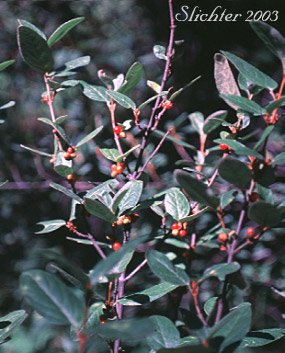
 The
photo at right shows the upper branches of Canada buffalo-berry as seen along
the South Fork of the Sun River, Bob Marshall Wilderness in Montana........July
27, 1999.
The
photo at right shows the upper branches of Canada buffalo-berry as seen along
the South Fork of the Sun River, Bob Marshall Wilderness in Montana........July
27, 1999.
Canada buffalo-berry is an attractive deciduous shrub from 1-4 meters high. The young twigs are covered with reddish-brown scales while the older twigs are brown. All twigs lack the spines found on Shepherdia argentea. The leaves are ovate to ovate-lanceolate in shape, with short petioles. They measure 1.5-6 cm in length and 1-3 cm wide. The upper blades are green The lower leaf surfaces are white with small, reddish-brown, bran-like scales.
The flowers are single or in small clusters in the leaf axils. They appear either before or as the leaves appear. The flowers are greenish yellow with the calyx limb about 4-5 mm wide. The sepals are are 1-2 mm long and spreading to reflexed. Male flowers are found on separate plants from the female flowers. The fruits are orange-red berries which are ellipsoid in shape and 6-8 mm long (See photo.).
Canada buffalo-berry is similar in appearance to snowberry but can be identified due to the rusty-brown scales on the lower leaf surfaces.
Canada buffalo-berry is found in open areas, open woods, and in riparian woodlands. It is often found in grand fir, western larch and lodgepole pine forests.
Canada buffalo-berry is found from Alaska south to Oregon and east to the Rocky Mts. and east to the Atlantic states.
Also known as soapberry, Native Americans crushed the berries and mixed them with water to create a soapy liquid used as a drink. The berries are edible although very tart. They make a good jelly when mixed with sugar. Buffalo-berry is a good nitrogen-fixing plant. It is also an attractive shrub suitable for garden use to the east of the Cascades.